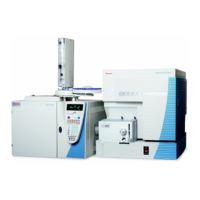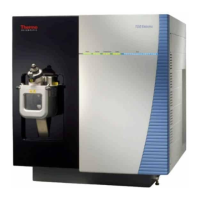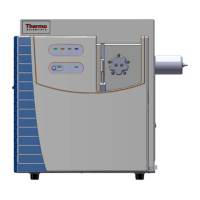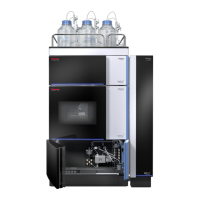2
Functional Description
Mass Spectrometer
Thermo Scientific TSQ Series Hardware Manual 33
Three expressions convey the efficiency of the CID process:
• Collection efficiency
• Fragmentation efficiency
• Overall CID efficiency
Collection efficiency: The ion flux ratio measured at the exit of the collision cell and at its
entrance. With no collision gas present, the TSQ mass spectrometer obtains virtually 100
percent collection efficiency. Collection efficiency is a mass-dependent parameter. For
example, with mid-range collision gas pressure, the collection efficiency might vary from
about 50 percent for comparatively less massive ions (which are more prone to scatter) up to
75 percent for comparatively more massive ions (which are less prone to scatter).
Fragmentation efficiency: The fraction of the ion flux at the exit of the collision cell that
results from fragmented ions. Fragmentation efficiency depends directly on the stability of the
ion and indirectly on the mass of the ion. The more stable the ion, the less likely a given
collision will fragment the ion. The more massive the ion, the greater its ability to distribute
the vibrational energy imparted by a collision. As a result, ion fragmentation might decrease.
With mid-range collision gas pressure, fragmentation efficiency might vary from 15 percent to
65 percent for various compounds. As the collision gas pressure increases, the fragmentation
efficiency for all compounds approaches 100 percent due to multiple collisions. The
collection efficiency decreases, however, due to scattering.
Overall CID efficiency: The product of the collection efficiency and the fragmentation
efficiency. The overall CID efficiency exhibits a maximum with intermediate pressure. As the
pressure increases beyond the optimum value, more and more collisions take place, the
probability of scattering increases, and fewer and fewer ions pass through the collision cell.
Scattering results in the collection efficiency decreasing. The fragmentation efficiency also
decreases as the pressure is decreased from its optimum value, because fewer and fewer
collisions take place.
Quadrupole Offset Voltage
The quadrupole offset voltage is a dc potential applied to the quadrupole rods in addition to
the ramping dc voltage. The offset voltage applied to the two rod pairs of the assemblies is
equal in amplitude and equal in sign. The quadrupole offset voltage accelerates or decelerates
ions and, therefore, sets theTKE of the ions as they enter the quadrupole rod assembly.
In general, for a given experiment, the TSQ mass spectrometer has fixed offset voltages for Q1
and Q2. However, in MS/MS experiments, the quadrupole offset voltage applied to Q3
usually varies as a scan proceeds. The TSQ mass spectrometer automatically computes the Q3
quadrupole offset voltage necessary and then varies the voltage, as appropriate, as each scan
proceeds.

